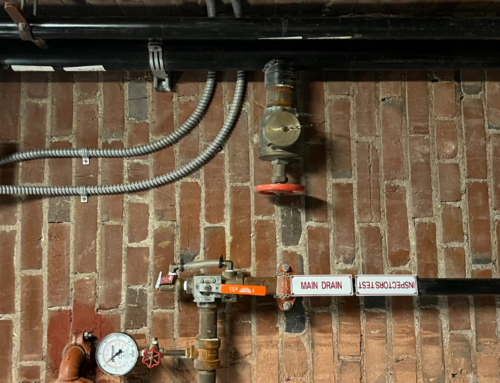The Future of Building Automation Expected to Bring Better Accessibility
Technology gives traditionally independent building systems the ability to more easily work together.

The adoption of technology in institutional and commercial buildings has historically been slower than elsewhere in society. After the desktop PC became ubiquitous in our workplaces, we still struggled for widespread adoption of direct digital controls (DDC) in our buildings. Thankfully, there have always been intrepid building owners and facility managers who will embrace technology, allowing the industry to gain practical experience to improve the quality and economics of technology for subsequent adopters.
The growth of digital building controls is similar to the growth of the internet. Adoption started with the relative few, but then grew to seemingly universal use. However, if you consider the smartphone, we quickly see that the way many of us interact with the internet is very different from how we interact with our buildings. By distilling and digesting the vast landscape of possibilities on the internet in easy-to-use apps, smartphones put the possibilities of the internet in people’s hands in an approachable and useful way. For many managers, the interfaces with their buildings and the data they house are more akin to that early information superhighway, a vast landscape rich with data and opportunity, but without tools to guide them how to utilize it.
The next decade may not see a revolution in available technology for our buildings, but we also may not need it. The fact is that there are industries, technologies, and products available for our buildings that can provide that guidance. Several owners have implemented them with success, several are still skeptical of using them, and some are not even aware of the possibilities. The tools that exist and are poised for proliferation enable use of the data that our buildings have been generating, fulfilling the promise of ease and efficiency that, in large part, have not been realized for many building owners.
What the next decade is likely to bring us in building automation and integration is access. This means access between systems that have traditionally been independent, access to the systems for the technical people supporting buildings, and access to information the building has about use and performance for decision-makers. This access will let building owners and operators make more informed decisions about space utilization, improve the user’s environment, and meet energy and carbon reduction goals.
Systems integrators
Building automation providers have long been the de facto systems integrators for projects. With the most experience in enterprise-level integrations and existing relationships with owner information technology departments, they have been the most likely (though not always necessarily the most willing) team members to undertake this role. The increasing number of building systems included in integrations will place an increased demand for this role from both technological and leadership considerations. This will leave a vacuum to be filled by people who are organized, can communicate well, and have strong technical abilities.
Fueled by the need for interoperability, the requirement of cybersecurity, and convenience for building operators, ad hoc Ethernet networks with standalone servers for building automation networks will be forced by the wayside. Building automation servers squirreled away in closets or under desks that do not receive proper operating system maintenance or security patches have become increasing threats on corporate IT networks. Absence of good solutions to this problem has been one obstacle of the industry, but platform development has given us the ability to address this issue head-on and improve the user experience at the same time.
Keeping IT infrastructure and security in the hands of IT professionals rather than outside vendors is becoming more the norm and less the exception. Scaling of the enterprise server software for building systems to server solutions has enabled these platforms to be installed on servers in the owner’s data framework, within their cabling infrastructure, and cloaked with the protection of their security. Increasing support of SAML and LdDAP access protocols by building system software has two key benefits for owners: corporate IT security permissions are shared by the building systems, and users enjoy the advantage of a single-logon experience. More sophisticated integrations can even leverage user data provided by the owner IT user profiles to the building system interfaces to tailor permissions and home screens based on job function.
Beyond a reliance on IT departments for security, the building industry has recognized the need for increased security within its systems. Understanding a need to evolve BACnet for improved security, ASHRAE developed and released BACnet Secure Connect (BACnet/SC) in November of 2019 and followed up by establishing the BACnet/SC Interoperability Acceleration Program in February 2020 to help manufacturers integrate the new system requirements. Manufacturers are also addressing security within their system architectures more than they have in the past.
Building data interoperability
As simple as it sounds, an important evolution of building data has been the understanding that it is a database problem. Traditional approaches to building automation have been a focus on sequence programming and graphical user interface development, leaving trending data as a final parting thought, whose collected results are often too cumbersome to evaluate efficiently.
Further, the connections to the program and graphic interface have been laborious, discrete one-to-one connections that are time-consuming and leave room for error. Adjusting our understanding that data points in a building automation system are not independent dots to which we must connect individual lines to form a picture, but a relational database to be queried for the report we need to populate is a subtle but important difference in approach. Accordingly, tools have evolved to apply improved structure to the database of our buildings.
One such powerful tool is semantic tagging of data. Rather than identifying information by a single specific point (AHU-1 Discharge Air Temperature), we can model points as an assembled string of specific attributes (AHU-1 + Discharge + Air + Temperature). Semantic tagging of data is a method by which a standard library of attributes are assembled to each data point in the automation system. This results in more powerful queries of data. For example, rather than the traditional approach of creating a trend report to display the discharge air temperature (DAT) of all 20 air handling units (AHUs) in the building by creating the report, then linking the DAT trend of each of the 20 AHUs to that report, we query the database for all records containing discharge, air and temperature. If we add or subtract units, we simply refresh the query, rather than manually reconfigure a specific report.
These semantic tagging models are not the notion of a dreamer, they are established systems that have been in use in the industry for almost a decade. Project Haystack and the Brick data model are the leading industry ontologies that are cooperating with ASHRAE for development of Standard 223P to define semantic data models for building data.
Structured building data allows buildings to take advantage of the trend of the Internet of Things (IoT). For distributed processor architectures (Edge devices) or centralized processor architectures (Cloud systems), IoT allows specific building data to be applied to broader evaluation techniques to present data in a meaningful way to building owners and operators and provide more sophisticated evaluation of the data.
Building analytics and automatic fault detection
Very often grouped together, building analytics and automatic fault detection are complimentary functions that can be applied to the data in buildings to give owners and operators valuable insight to building behavior. Building analytics can provide useful performance metrics for building operation that can inform decisions about space utilization, occupant comfort, and energy performance. Automatic fault detection could be thought of as similar to alarming but can be smarter since they are informed by more information than simple failures. Think of them as pre-alarms.
While these software platforms have been commercially available for some time, their adoption is increasing in application. Initially marketed primarily by traditional building automation vendors, expansion of providers of these systems and services by other organizations has improved the economics and performance of their application. The advances of building data operability have been key in making application of these technologies more accessible for these software applications.
Mobile applications: Many users fail to understand why it’s relatively simple and economical for them to have a smart, integrated experience with their home systems available at their fingertips on their smartphone but lack a similar experience for their buildings and campuses that have multi-million-dollar control systems. The simple fact is that the packaged, unitary nature of residential equipment simplifies automation efforts, and people’s neglect of their cybersecurity empowers the ease of access. For larger, more complex systems that have advanced capabilities to maintain occupant comfort and optimize energy efficiency, more engineering is required to make that data available on mobile platforms. Additionally, corporate society’s respect and value for cybersecurity means linking enterprise-level systems and exposing their combined data to mobile platforms requires coordination between several different departments and vendors. These interfaces are possible today, but at an effort and cost that may not be justified for a lot of building operators. More and more vendors are developing improved mobile applications for their platforms, and we’ll see this continue, making the technology approachable to more buildings.
Commissioning: Beyond the growing requirement of commissioning of building systems by building certification programs and building codes, commissioning remains an important part of the process for successful realization of a building’s information systems. Many building owners still struggle to understand the value of commissioning or are under the impression that, “I think I’ve already paid someone for that.” In an oversimplified example, if a design for integration between Vendor A and Vendor B exists in a set of contract documents, who in the project is responsible to verify and test that the integration works after each report to the general contractor that “I did my part,” but no information is being exchanged? That level of verification and support is not common for the design team for the negotiated fees. General contractors frequently lack the technical expertise to verify or guide the process. These “gaps” in responsibility, or more importantly, areas that require additional or specialized coordination, are filled by commissioning providers. The increased complexity of these building systems further increases the value in commissioning of building systems.
Many of these tools can be applied to existing building automation systems. These tools may also be considered and planned in new buildings or in retrofits of existing buildings. Any way they’re implemented, teaming with the right partners and providers can make your building data systems work for you. The successful integration of building systems on corporate IT networks that have structured databases formatted to support building analytics platforms can be presented to people in the boiler room, the office workspace, the chief financial officer, the mechanical service provider, the MEP consultant, or the city benchmarking database to facilitate a collaborative experience to get the best out of our buildings, and for us to define what best looks like.

Kyle Knudten, P.E.
Published April 27, 2022 in Facility Maintenance Decisions
Kyle Knudten, PE, is a principal at McClure Engineering, a mechanical and electrical consulting engineering firm dedicated to the development of innovative solutions to unique engineering problems.



